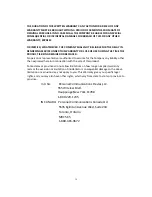
24
Speakerphone:
Select
whether
or
not
to
enable
the
speaker.
6.11
Tone
Room
Deluxe
TBD.
6.12
Pac
‐
Man
TBD.
7
Safety
and
Warranty
This
chapter
addresses
the
safety
guidelines
and
precautions
to
follow
when
operating
your
phone.
Before
operating
your
phone,
please
be
aware
of
all
the
safety
details.
This
chapter
contains
the
terms
and
conditions
of
services
and
the
warranty
for
your
phone.
Please
review
them
thoroughly.
7.1
SAFETY
INFORMATION
FOR
WIRELESS
HANDHELD
PHONES
READ
THIS
INFORMATION
BEFORE
USING
YOUR
HANDHELDPORTABLE
CELLULAR
TELEPHONE
EXPOSURE
TO
RADIO
FREQUENCY
SIGNALS
Your
wireless
handheld
portable
telephone
is
a
low
power
radio
transmitter
and
receiver.
When
it
is
ON,
it
receives
and
also
sends
out
radio
frequency
(RF)
signals.
In
August
1996,
the
Federal
Communications
Commissions
(FCC)
adopted
RF
exposure
guidelines
with
safety
levels
for
handheld
wireless
phones.
Those
guidelines
are
consistent
with
the
safety
standards
previously
set
by
both
U.S.
and
international
standards
bodies:
ANSI
C95.1
(1992)
*
NCRP
Report
86
(1986)
*
ICNIRP
(1996)
*
Those
standards
were
based
on
comprehensive
and
periodic
evaluations
of
the
relevant
scientific
literature.
For
example,
over
120
scientists,
engineers,
and
physicians
from
universities,
government
health
agencies,
and
industry
reviewed
the
availablebody
of
research
to
develop
the
ANSI
Standard
(C951).
The
design
of
your
phone
complies
with
the
FCC
guidelines
(and
those
standards).
1*
:
American
National
Standards
Institute.
2*
:
National
Council
on
Radiation
protection
and
measurements.
















































